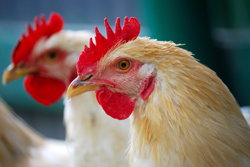Dry chemistry concept for speedy automated toxin assay
Coccidiostat residues that can occur in poultry products are cause for concern. Almost all commercially reared chickens have been dosed for protozoal infection with coccidiostats throughout their lives. Consequently, there may be toxic residues in meat and eggs that the consumer may be totally unaware of. European regulations governing safety within the food chain from the 'field to the fork' incorporate monitoring of food residues by the National Reference Laboratories (NRLs). However, previous to this research spearheaded by the European project POULTRY-CHECK, lack of appropriate methods hampered the enforcement of residue control directives. As part of the research to correct this situation, the consortium team at the University of Turku in Finland developed a screening assay based on immunochemistry and time-resolved fluorometry. The test was aimed originally at screening for three of the main coccidiostats in use in the industry. A superior level of accuracy is possible due to the use of highly specific polyclonal antibodies. Assay time is very rapid at 18 minutes per sample due to the use of an all-in-one dry chemistry immunoassay. All reagents in dry form are contained in microtitration wells. The immuno-assay is one-step and is extremely simple for the end-user as all that is required is addition of the sample. Furthermore, the dry chemistry concept also allows automation of the protocol with the addition of an immunoanalyser. The new time-resolved fluorescence label technology employs intrinsically fluorescent lanthanide chelates that provide a highly sensitive assay with chemical stability, also suitable for automation. Furthermore, lack of background fluorescence means the signal can be measured directly from the solid phase surface without the need for any signal enhancement. The assays have been validated according to the relevant Commission Decision and promise the accuracy, speed and simplicity demanded for detection of toxic agents throughout the food chain. An added advantage is that the basic assay design can be adapted for use with other toxic residues.



